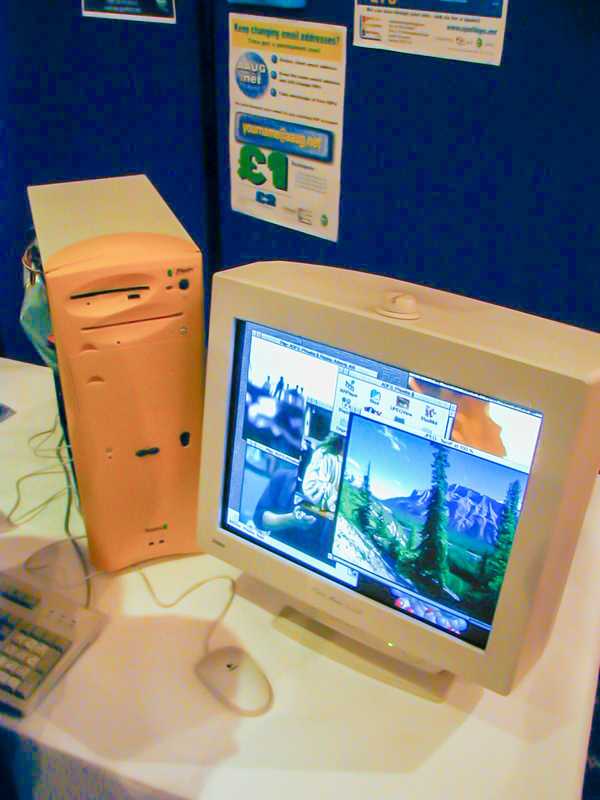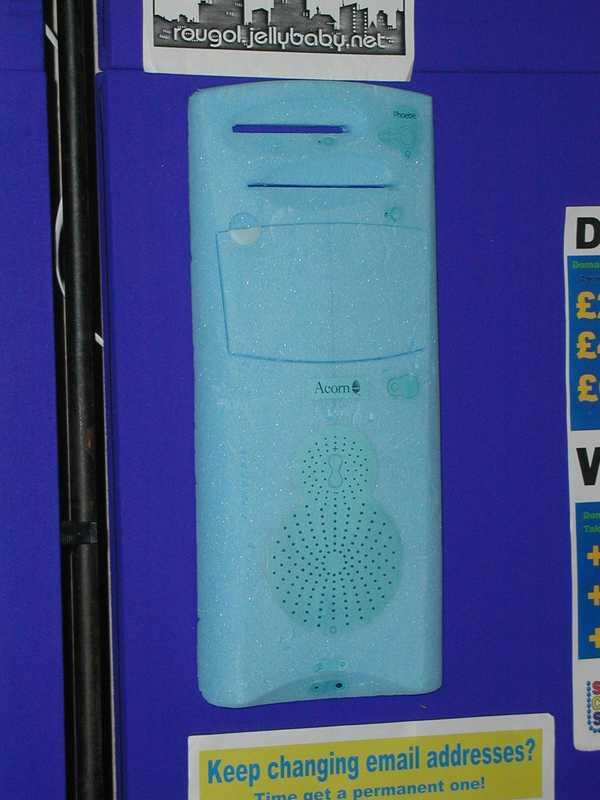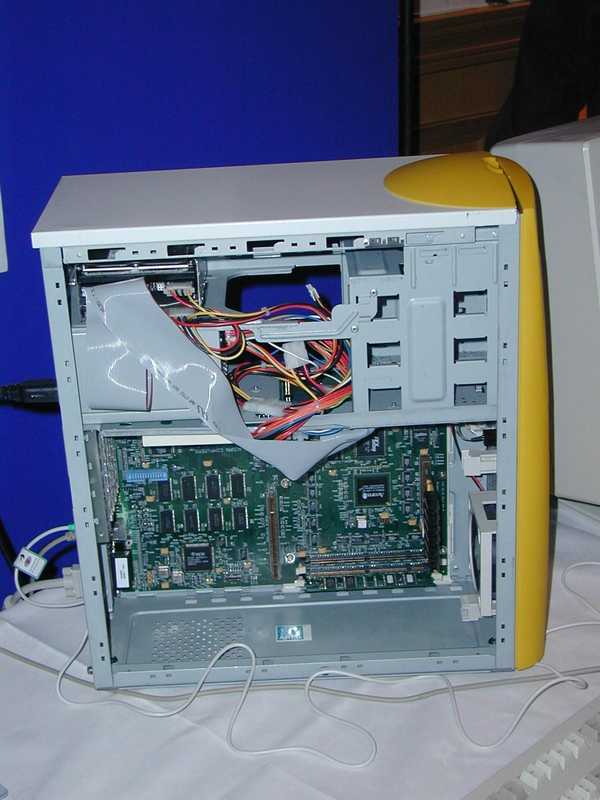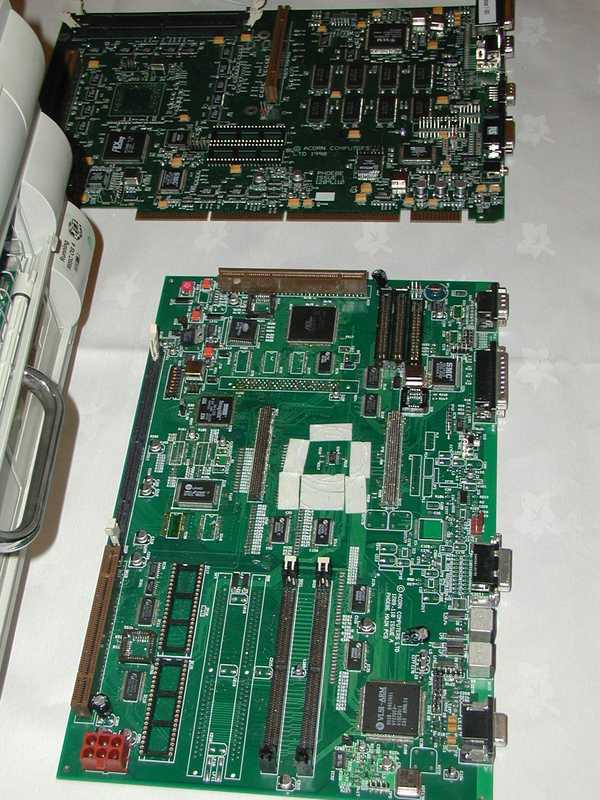Phoebe
The machine that killed Acorn.
I only owned the case for this machine because, unfortunately, Acorn only ever managed to build two prototypes before the company went under.
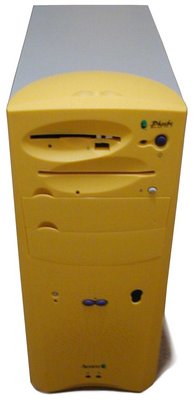
Project Phoebe
I can remember going up to Cambridge to attend the Developer's Conference where Phoebe, the successor to the RiscPC, was unveiled; in the pre-iMac days when computers were all beige boxes this was a bold, striking design step. Of course some of us didn't like the mustard-yellow, wishing for something more in keeping with the Acorn legacy - Acorn green perhaps, or some wanted black or red. Apparently green didn't work in this type of plastic, but the striking colour was obviously intended to bring about discussion, and so publicity. After all, didn't a slight change of colour help the Proton prototype become the BBC Model B we all knew and loved?
The Phoebe wasn't just a case however; a new OS, RISC OS 4, would be behind it, with its pastel coloured icons and jigsaw puzzle piece shaped new modular configuration program, and internals that did away with the old, expensive podule style expansion cards for standard PC style ISA(?) cards. An entirely new machine.
Oh, and the name? It comes from the TV show Friends; one of the main characters was called Phoebe, and that was the codename for the project. There was a competition to find a better name, but no-one won so Phoebe remained, to the point of being printed on the case. Continuing with the Friends theme, Phoebe had an evil identical twin called Ursula, which was used as the code name for RISC OS 3.8 - the new version of the OS which finally saw the light of day as RISCOS Ltd's RISC OS 4. Rachel was the processor card, and Chandler the IOMD2 chip.
David Cotton, who was at Acorn at the time, saw an earlier version of this page and had this to say about the IOMD2 chip:
Chandler was in many ways the crux of the project, and it cost an absolute fortune to develop - we got the first ten samples through at the beginning of the week that the project was cancelled, and had only two soldered down on Revision 1 boards by the time of the canning. Hence there are only two working Phoebe's in the world.
David Cotton
Aftermath
I was honoured to design the website for the launch show, Acorn World 1998 at the London Arena. Basing the design on the Phoebe itself as Acorn requested, I created a site where the logo was always overlaying an indented CD drive bay; the sponsors logos in the first drive bay; and large puzzle piece shaped icons in the second drive bay. It was (for the time) stylish and colourful, and in step with the magazine advertising.
But then the launch was cancelled, and with it the show. Acorn had ploughed all its time and money into the new machine, years of development and millions of pounds - they gambled that they could get it to market and make the money back, but it was a gamble they lost. To some of us it seemed incredible - forget that we thought that there'd always be an Acorn, what about all of that time and money? How could they give up when they were so close? To others it had only been a matter of time, and they informed us sagely that it had been on the cards for a while.
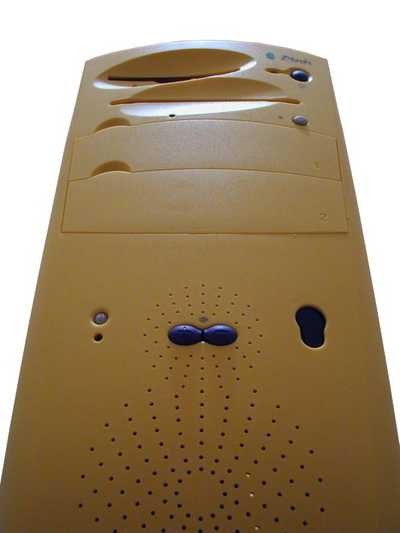
The machine was so close to completion that the initial batch of cases were ordered, in fact two distinct types - matt and gloss. These sat in a warehouse until someone decided to sell them as souvenirs, no computers inside but tantalising glimpses of what might have been, complete with wiring for the power switch, the indicator lights etc. They were snapped up pretty quickly, and I only just managed to get a hold of one. I helped run a RISC OS news site at the time, but even so I was almost too slow to get on the waiting list.
Then it turned out that ARM, which Acorn had started to design chips for their desktop machines, had gone on to do so well that it was now worth far more than its parent company. It still continues to dominate the mobile market today, because the low power consumption of the ARM chip makes it ideal for such devices as mobile phones and tablets. Acorn fell apart; ARM bought itself out of Acorn with some strange share deal that no normal Acorn punter could understand; then there was E14 (Element 14, which is of course Silicon); but finally all the useful remnants were bought by Pace, who designed set top boxes.
Seeing it up and running
At the RISC OS 2001 show in Berkshire there was a working Phoebe prototype on display for the first time, along with some other interesting bits and pieces. I wrote up a show report for The Icon Bar, and the relevant bits have been reproduced below:
There was a real blast from the past at the show, and one of the reasons I decided to go at the last minute: as promised a working Phoebe prototype was in evidence near the theatre, and even though it was only really a prototype it was already running fast enough to display four or five Replay movies at the same time, and render an ArtWorks document as well, without appearing to slow down. It's a couple of years old, it hasn't been optimised, and yet it still beats anything we have at the moment. Sadly it'll never be anything more than a museum piece though, especially as there are no PCI drivers (the cards power up, but there's no software to run them) and as there was no CD ROM (lack of compatible drivers) or floppy drive (broken connector?) installed either it was pretty hard to get software on it! (putting the hard drive into another RiscPC was the eventual solution). I won't wax lyrical about all the bits and pieces, but I took plenty of 'photos to add to my own website. There was the pizza oven slice fitted to a regular RiscPC (although sadly no free samples of food in evidence!); a production model of a fax machine developed by Acorn for a client who then had to junk almost the entire run because of problems from a rival company; and a triple video output card as used in service stations to display info on multiple monitors from one RiscPC.
RISC OS 2001 show report, The Icon Bar, 23rd October 2001
Specification
I happened to come across my copy of the project spec, which must have been handed out at the conference. I have reproduced the machine specification below:
2.0 Overview
- Processor
- 233Mhz StrongARM on board running at 64MHz I/O
- Performance
- 450k Dhrystones on a monitor supporting 70Hz modes.
- Processor expansion card
- Interface to support upto 4 x 233Mhz StrongARMs on single processor card). The card will not form part of this project.
- FPA support
- not available
- Floppy drive
- Single 2MB unformatted
- Hard disc
- 1 T.B.D. size IDE HD with expansion for a further 3.
- CD ROM/DVD ROM
- 32x slot CD ROM fitted as standard. DVD ROM upgrade possible
- Total RAM
- SDRAM support only.
- DRAM
- Expansion upto 512MB of SDRAM with 1 or 2, 32MB SDRAM DIMMs as standard.
- ROM
- 4MB - board layout allocated for up to 8MB.
- VRAM
- 4MB EDO VRAM fitted to board
- Video
- up to 1024x768 non-interlaced in 32bpp. 1280x1024 24bpp
- Drive bays
- 3 x 5.25", I x 3.5" visible bays, and 2 x 3.5" hidden bays
(1 x EIDE drive, CD and 3.5" floppy fitted as standard) - Free Drive Bays
- 2 x 5.25" visible expansion bays and 1 x 3.5" hidden as standard
- PCI interface
- 4 slots compliant with PCI 2.1 spec (32Mhz 32Bit PCI)
- Extended podule slots
- Backplane connector similar to RISC PC's allowing 3 slots
- Case type and volume
- NLX Mini Tower case, volume = 450x450x190mm (approx.).
- Network support
- 10 and 100 Base-T Ethernet support using a PCI card slot if req.
- Parallel port
- Enhanced bi-directional multimode parallel port as per RISC PC
- Serial ports
- 2 standard PC-AT style ports and IrDA support. Each will support baud rates up to 460k Baud (the actual performance achieved will depend on software running, user upgrades, screen mode etc.).
- ID chip
- fitted as per RISC PC
- Sound system
- 16 bit digital CD quality provided by Soundblaster compatible CODEC and VIDC20 sound systems. The Soundblaster sound and Acorn sound are mixed with CD/DVD output
- Line input/output
- Stereo 3.5mm jack sockets on rear
- Microphone input
- Mono 3.5mm jack socket on front of case
- Internal speakers
- Mono
- Headphone output
- Fitted on front, inserting headphone switches off speakers
- Joystick
- 15 way D-type standard PC game port for dual joystick support
- MIDI support
- MIDI input and output at rate of 31.25K baud on game port
- PSU
- 230W NLX standard PSU
For comparison:
RISC PC700:
ARM710, 50k Dhrystones in MODE 0, up to 2 IDE devices, 2MB floppy disc, or 16MB RAM, 10,1,2MB VRAM, 800x600x32b video, 4 single Podule slots, Ethernet network card replacing one single Podule slot, bi-directional parallel port, serial port, headphone socket
The upgrade will offer in the region of 150-200% of the performance of a StrongARM RISC PC
